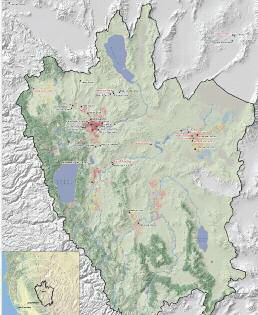edible notables
EAT LOCAL
Group sets goal to consume 20% local food by 2020.
WRITTEN BY HEIDI KRATSCH AND JANA VANDERHAAR
FOODSHED MAP CREATED BY TOM DILTS, COURTESY OF GREAT BASIN COMMUNITY FOOD CO-OP
The USDA estimates that a family of two can eat at home for between $500 and $800 a month and a family of four for between $700 and $1,200.
“So, let’s take an average of $800 per month and say there are 150,000 families in Northern Nevada,” says Phillip Moore, Local Food Network in Reno board member. “That’s $1.5 billion that is spent every year in our area alone, assuming everyone eats at home.”
|
This map shows the location of local farms that supply the Great Basin Community Food Co-op. The co-op defines locally produced goods as those sourced within our foodshed, which is based on the three closest river systems and their watersheds/drainages: Truckee, Carson, and Walker rivers. In the map’s bottom left-hand corner, a miniature version displays concentric circles that indicate where the 100-, 200-, and 300-mile radii lie |
Currently, less than 2 percent of that money is spent on food that is grown or produced locally. The need for creating a local food system — by forming a collaborative network of farmers, chefs, grocers, nonprofits, regional food-advocating entities, and consumers — began during a Community Food Security breakout session at the 2006 Agricultural Summit in Reno. That’s when the Local Food Network was born.
“We set a goal of 20 percent by 2020,” says Tom Stille, owner of River School Farm in Reno and co-founder of the Local Food Network in 2007. “This is an idea that gives an achievable goal of bringing more local food to our region. To date, there is no question that we have more opportunities to buy locally than five years ago when we started.”
To define the scope of work, network members first looked at what a local food community is. That was defined as the people involved in producing, distributing, and consuming food linked to a geographic area. In our case, local watersheds provide the essential water for growing food locally.
The Local Food Network has accomplished five major goals to give local food a foothold in the Truckee Meadows:
1. Formed an organization that supports Nevada farmers: www.NevadaGrown.com
2. Began a food cooperative that buys directly from local farms: Great Basin Community Food Co-op (http://www.Greatbasinfood.coop/)
3. Increased community-supported agriculture programs
4. Helped support the maintenance of a local meat processing facility: Today, Wolf Pack Meats on the University of Nevada, Reno campus is the only USDA-certified local meat processing and packaging facility
5. Launched educational opportunities to learn about local food and how to grow one’s own food: Today, the network continues to gather with local food partners on a quarterly basis, sharing information and identifying new initiatives. Working on this strategic 20 by 20 plan will further the availability, affordability, and desirability of local food in the greater Truckee Meadows.
Heidi Kratsch is the horticulture specialist with the University of Nevada Cooperative Extension. Her passion is sustainable urban agriculture systems, and she believes small-scale and local is the future of agriculture. Jana Vanderhaar is a Reno landscape architect and local food leader and advocate.
Resources
Take the Local Food Pledge!
Choose to make 10 percent of your diet come from local sources.
Here are some tips on how to help shift your global diet to a local one
1) Patronize restaurants and grocers that source locally: shop at the Great Basin Community Food Co-op for vegetables, meat, and seeds from local growers and ranchers, and learn about their local food distribution center at www.greatbasinfood.coop
2) Shop at local farmers’ markets from Nevada farmers or farmers on this side of the Sierra Nevada. Learn about local farmers at www.NevadaGrown.com
3) Join a CSA (community-supported agriculture) by subscribing to a weekly local food basket such as Great Basin Basket CSA or River School Farm CSA, www.riverschool.info
4) Check food labels and buy those products that come from the nearest source. Review the local foodshed map at www.greatbasinfood.coop/about-us/local-foodshed-map/
5) Learn to grow some of your own food, such as herbs outside your kitchen door. Workshops are held at local nurseries and at UNCE “Grow Your Own” series at www.unce.unr.edu/resources/horticulture/growyourown/
6) Partner with neighbors to create a neighborhood community garden
7) Eat what’s in season, so your food has not traveled as far as out-of-season vegetables. Learn what’s in season in edible Reno-Tahoe.
Why Local?
The purported benefits of eating locally produced foods are many. Here are a few reasons:
1. Eating local is good for local economies, supporting local growers and allowing those growers to hang on to a greater proportion of their food dollar that would otherwise be spent on processing, packaging, refrigeration, and transportation of their product.
2. Eating food that is grown locally helps reduce carbon emissions into the atmosphere by reducing the distance food has to travel to reach your plate. This means less fossil fuel is used in the transportation of our food across the country or even across the globe.
3. Not having to worry about transportation helps local growers focus on flavor and nutritional value rather than sturdiness of the produce to survive in a box in a refrigerated truck on the road to a long-distance destination.
4. Local produce can be picked at its peak of freshness, flavor, and nutritional content and delivered to grocers, farmers’ markets, or restaurants in the area on the day of harvest, thereby retaining their water-soluble nutrients and antioxidants.
5. Local growers tend to deal with a greater variety of crops, increasing the biodiversity of our food supply and protecting otherwise unknown or little-used heirloom varieties.


